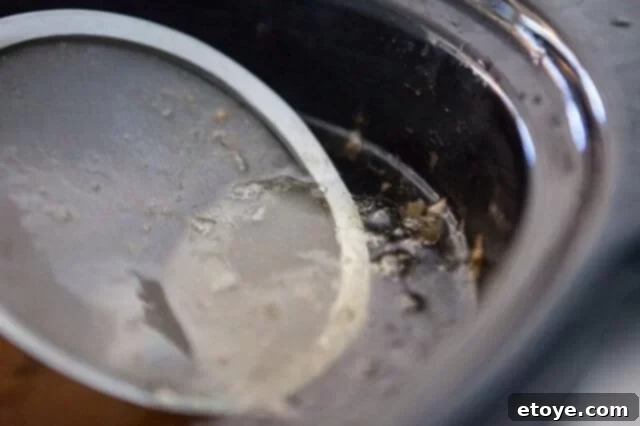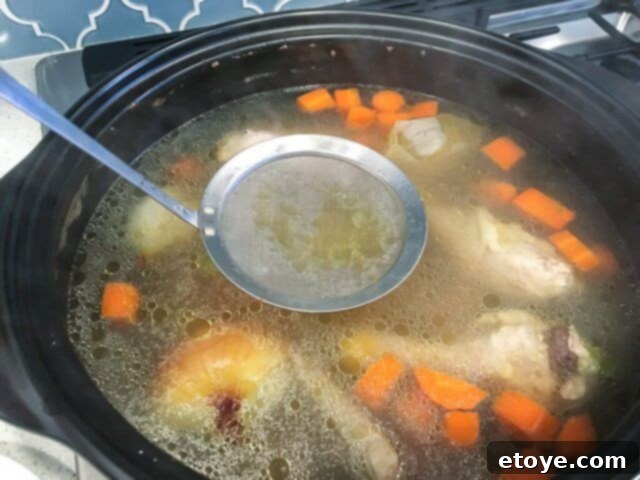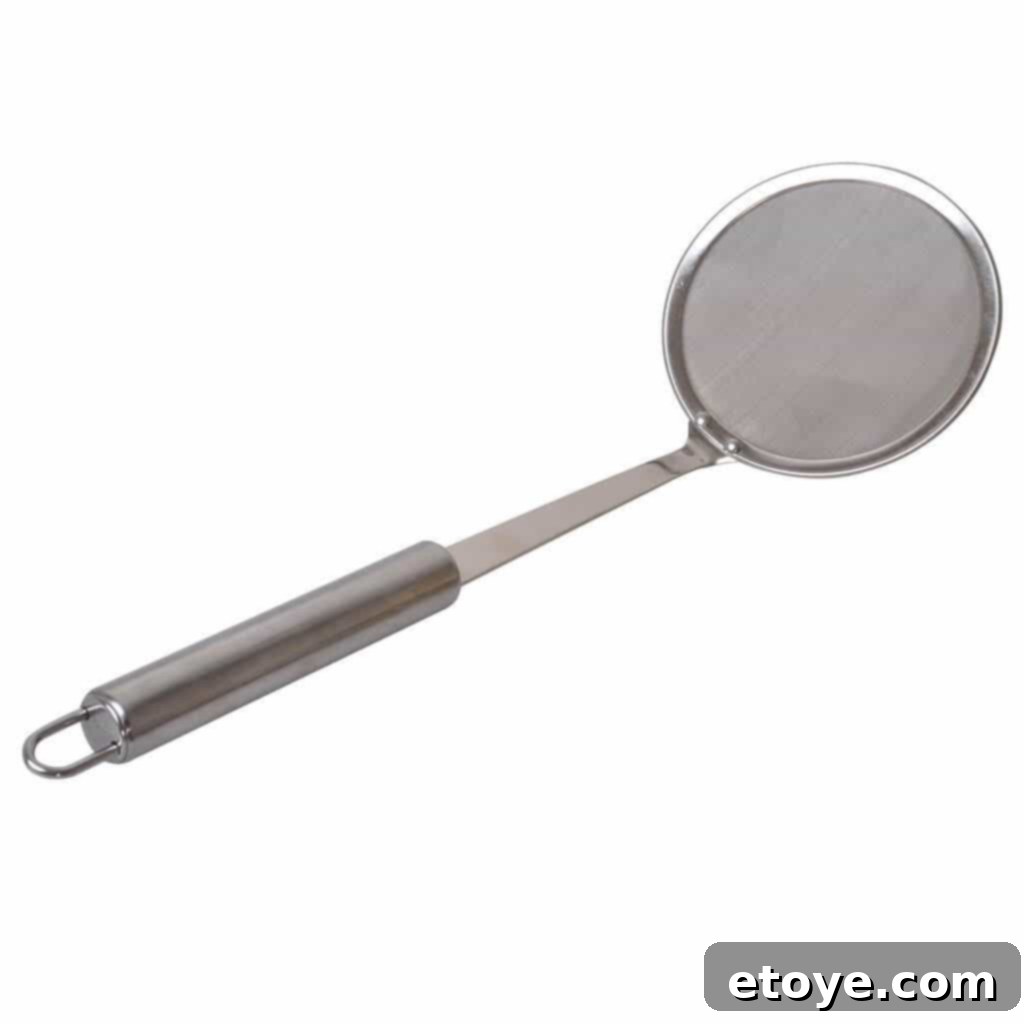Ah, the age-old dilemma for any home cook – how to remove that pesky layer of fat from your lovingly prepared stock or sauce. We’ve all been there, right? You’ve simmered your stock to perfection or your sauce to just the right consistency, only to find a slick of oil marring the surface. This unwelcome grease can detract from both the visual appeal and the delicate flavor of your culinary masterpiece. But fear not! Achieving a crystal-clear, rich broth or a velvety smooth sauce doesn’t have to be a daunting task. I’ve discovered what I believe is a near-perfect solution, alongside several other reliable methods, to ensure your dishes are always at their absolute best, free from unwanted greasiness.

Effective Ways to Remove Excess Fat from Your Cooking
Every home chef encounters the challenge of excess fat, whether it’s floating on a savory chicken stock or marring a delicate sauce. While it’s sometimes an unavoidable part of the cooking process, dealing with it effectively ensures your dishes are as clean, flavorful, and visually appealing as possible. Having a versatile array of techniques at your disposal is invaluable, allowing you to tackle different cooking scenarios with confidence and ease. From ingenious kitchen hacks to specialized gadgets, these methods offer simple yet efficient ways to achieve that coveted clear, grease-free broth or perfectly textured sauce that truly elevates your culinary creations. Let’s explore some of the most accessible and effective strategies.
- The Ice Cube Trick for Quick Fat Removal: This clever method harnesses the power of cold to solidify and capture fat quickly. Simply glide a few cold ice cubes (or even a small bag of ice) along the surface of your hot soup or stock. As the ice passes over, the fat particles rapidly congeal and stick to the cold surface. You can then easily lift away the ice cube, taking the solidified fat with it. This technique is particularly useful for small batches or when you need a swift solution, though care must be taken to prevent excessive water dilution if the ice melts too much. It’s a fantastic emergency fix for unexpected grease.
- Paper Towel or Napkin Absorption Method: For a gentle and straightforward approach, the paper towel or napkin trick is incredibly effective. Carefully lay a single sheet of paper towel or a clean napkin directly onto the surface of your liquid. The absorbent material will quickly soak up the fat particles that are resting on top, leaving the liquid behind. Gently lift the paper towel away, and you’ll see the absorbed grease. For larger quantities of fat, you might need to repeat this process a few times with fresh sheets. This method is excellent for soups, stews, and sauces, and requires no special equipment, making it a universal kitchen hack.
- Utilizing a Fat Separator for Pristine Liquids: A fat separator is a dedicated kitchen tool designed specifically for this purpose, often resembling a large measuring cup with a spout originating from the bottom. To use it, simply pour your stock, soup, or sauce into the separator. Allow it to sit for a few minutes; the fat, being lighter than water, will naturally rise to the top and form a distinct layer. Once separated, you can then pour out the lower, fat-free liquid directly from the bottom spout, leaving the unwanted fat behind. This tool is especially handy for making gravies, jus, or large quantities of broth, offering a clean and efficient separation with minimal effort.
- The Chilling Technique for Thorough Degreasing: If time is on your side, the chilling technique offers one of the most comprehensive ways to remove fat. After cooking, allow your stock, soup, or stew to cool completely, then transfer it to the refrigerator. As the liquid chills, the fat will solidify into a firm, distinct layer on the surface. Once completely solid, you can simply lift this hardened layer off with a spoon, leaving behind a perfectly clear and grease-free liquid. This method is ideal for meal prep, making large batches of stock in advance, or for recipes that benefit from an overnight chill, ensuring maximum fat removal without any fuss.
Proactive Strategies: Preventing Excess Fat in Your Cooking
While mastering the art of fat removal is a valuable skill, an even better approach involves preventing excessive fat from accumulating in your dishes in the first place. By incorporating proactive strategies into your cooking routine, you can significantly reduce the overall fat content of your meals, leading to healthier, more balanced, and equally delicious outcomes. It’s not just about what you take out; it’s also about how you manage fat content from the very beginning of your culinary process. Understanding how to integrate fat more judiciously allows you to create lighter, yet still incredibly flavorful, dishes. Here are some fundamental tips and techniques to help you keep your dishes leaner right from the start:
- Choose Leaner Cuts of Meat and Trim Excess Fat: The foundation of a less fatty dish often begins with your choice of ingredients. Whenever possible, select relatively lean cuts of meat such as chicken breast, pork loin, or leaner beef cuts. If you’re working with fattier cuts like chicken thighs, pork shoulder, or beef brisket, make it a habit to trim off as much visible excess fat as possible before cooking. This simple, upfront step can drastically reduce the amount of fat that renders out during cooking and ends up in your final dish, forming a cleaner base for your stocks, stews, and roasts.
- Opt for Healthier Cooking Methods: The way you cook your ingredients plays a crucial role in fat management. Grilling, broiling, roasting, baking, and steaming are excellent methods that allow excess fat to drip away or cook off without requiring additional oil. Unlike frying or sautéing, which often involve cooking in added fats, these techniques help to render out the natural fats in meats and poultry, contributing to a lighter end product. For example, roasting vegetables with a minimal amount of oil, or baking chicken on a rack, ensures the fat drips into a pan below, rather than sitting in the dish.
- Cool and Skim Consistently: This technique, while also a removal method, is so effective it serves as a preventive measure for subsequent dishes. After preparing stocks, soups, or stews, especially large batches, allow them to cool down. As the dish cools, the fat will rise to the top and solidify, making it incredibly easy to skim off. This step is particularly beneficial for bone broths and slow-cooked dishes where significant fat rendering occurs. Removing this solidified layer before reheating or using the base for other recipes ensures a cleaner, healthier foundation.
- Enhance Flavors with Aromatics, Herbs, and Spices: Instead of relying on fat to carry flavor, cultivate a deeper appreciation for aromatics, herbs, and spices. Ingredients like garlic, onions, carrots, celery (the classic mirepoix), leeks, ginger, and citrus zests provide incredible depth and complexity without adding any fat. Fresh herbs such as thyme, rosemary, bay leaves, cilantro, and parsley infuse dishes with vibrant notes. A strategic dash of spices like cumin, paprika, or turmeric can transform a dish. Furthermore, a splash of acid, such as lemon juice, lime juice, or a good quality vinegar, can brighten flavors and cut through richness, creating a more balanced and less heavy eating experience.
- Be Mindful with Fatty Ingredients and Practice Portion Control: Ingredients naturally high in fat, such as cream, cheese, butter, coconut milk, and certain nuts, can be wonderful for adding richness and texture. However, they should be used judiciously. Practice portion control and consider if you truly need the full amount specified in a recipe. Often, a little goes a long way in terms of flavor and mouthfeel. You might find that you can achieve the desired richness or creaminess with significantly less than you initially thought, or even by incorporating healthier alternatives like pureed vegetables for thickening.
By consciously incorporating these techniques into your daily cooking routine, you can confidently enjoy delicious, satisfying meals that are inherently healthier and less laden with unnecessary fats, without ever compromising on taste.
My Go-To Method: The Unrivaled Ultra Fine Mesh Skimmer
While many methods exist for degreasing, not all tools are created equal, especially when it comes to capturing those elusive, tiny droplets of fat that can still leave your broth hazy. Many common skimmers, like those you’d find here or here, simply aren’t fine enough to tackle these smaller particles, often allowing them to slip through and re-contaminate your liquid. That’s precisely why my absolute go-to tool, a true kitchen essential, is this amazing Ultra Fine Mesh Skimmer. It’s more than just a utensil; it’s a real game-changer and a genuine life hack that every serious home cook should undoubtedly have in their arsenal.
What sets this particular skimmer apart is its incredibly dense and fine mesh construction. Unlike conventional slotted spoons or coarser skimmers, this tool is engineered to capture even the tiniest micro-droplets of fat that float on the surface of your liquids. It’s perfect for a wide range of applications, from small batches of delicate sauces to larger pots of simmering stock where you want absolute clarity. The precision of the mesh ensures that you’re removing only the fat, leaving behind a taste-rich, pure liquid without any greasy residue or significant loss of your precious broth. It’s especially invaluable when you’re dealing with relatively lean cuts of meat or poultry stock, where you might not have a thick, visible layer of fat but still desire that impeccably clean, neutral flavor profile.
For instance, when I make homemade chicken soup, I often start with a whole chicken, skin on. While the skin adds incredible flavor and gelatin to the broth, it also means the soup will inevitably be more oily. However, with this ultra-fine mesh skimmer, the task of achieving a perfectly clear and palatable broth becomes effortless. It systematically sifts out the rendered fat, leaving behind a golden, flavorful soup that’s a delight to the senses. This skimmer proves its worth time and again, demonstrating unparalleled efficiency in achieving a pristine liquid, making it an indispensable tool for anyone who values clarity and purity in their culinary creations. It significantly reduces the effort and time required compared to other, less effective methods.

As you can see from the following images, the skimmer is incredibly effective. This is the oil I managed to remove from my chicken soup after a thorough skimming session:

Indeed, this is all oil – proof of the ultra-fine mesh skimmer’s superior performance in leaving your dishes perfectly degreased!

Frequently Asked Questions About Fat Removal
Navigating the best ways to remove fat from your culinary creations can sometimes raise a few questions. Here, we address some common queries to help you achieve the clearest stocks, richest sauces, and healthiest meals.
Q: Can I use a turkey baster to remove oil from my soup or stock?
A: Absolutely, a turkey baster can be a very effective tool for removing excess fat, especially from larger quantities of liquid or when dealing with a thick, concentrated layer of fat on the surface. Its design allows you to precisely suck up the top layer of oil without disturbing the liquid underneath. Simply squeeze the bulb, place the tip into the fat layer, and release the bulb to draw the fat into the baster. This method is particularly useful for reaching into deep pots and can be quite efficient for quick degreasing. However, it requires careful handling to avoid sucking up too much of the flavorful broth.
Q: Is it possible to use a slotted spoon to skim fat effectively?
A: While a slotted spoon can certainly remove larger pieces of fat or any solids floating on the surface of your soup or stock, it is generally not the most effective tool for removing fine fat droplets or achieving a truly clear liquid. The slots in the spoon are too wide to capture the smaller grease particles, meaning a significant amount of fat will simply pass through. For more thorough and precise fat removal, a fine mesh skimmer or one of the other methods mentioned above, such as a fat separator or the chilling technique, would be significantly more effective.
Q: How effective are dedicated fat skimmers compared to homemade methods like using ice cubes or paper towels?
A: Dedicated fat skimmers, particularly the ultra-fine mesh variety, are designed specifically for the task and offer superior efficiency and precision. They excel at capturing even the smallest fat droplets, leading to a much clearer and cleaner end product, especially beneficial for large volumes of broth or recipes that produce a lot of fat. Homemade methods like the ice cube trick or paper towels are excellent for quick fixes, small batches, or when you’re without specialized equipment. They are effective to a certain degree but may require more effort, multiple passes, or might not achieve the same level of clarity as a purpose-built fine mesh skimmer.
Q: Why is it important to remove excess fat from stocks and sauces?
A: Removing excess fat is crucial for several reasons. Firstly, it significantly improves the texture and mouthfeel of your dish, preventing a greasy sensation. Secondly, it allows the true flavors of your ingredients to shine through, as excessive fat can sometimes mute or mask delicate nuances. Thirdly, from a health perspective, reducing the fat content makes your meals lighter and contributes to a healthier diet. Lastly, it enhances the visual appeal, resulting in a clearer, more inviting broth or a smoother, more refined sauce that looks as good as it tastes.
Q: Can I store the fat I’ve skimmed off, and if so, what can I use it for?
A: Yes, you can absolutely store skimmed fat, especially if it’s from a flavorful source like roasted chicken, beef, or bacon. Collect the rendered fat, strain it to remove any solids, and store it in an airtight container in the refrigerator for up to a few weeks, or in the freezer for several months. This flavorful fat can be repurposed for various culinary uses, such as sautéing vegetables, roasting potatoes (like duck fat roasted potatoes), making a roux for gravies, or adding richness to future soups and stews. It’s a great way to minimize waste and add an extra layer of flavor to other dishes.
